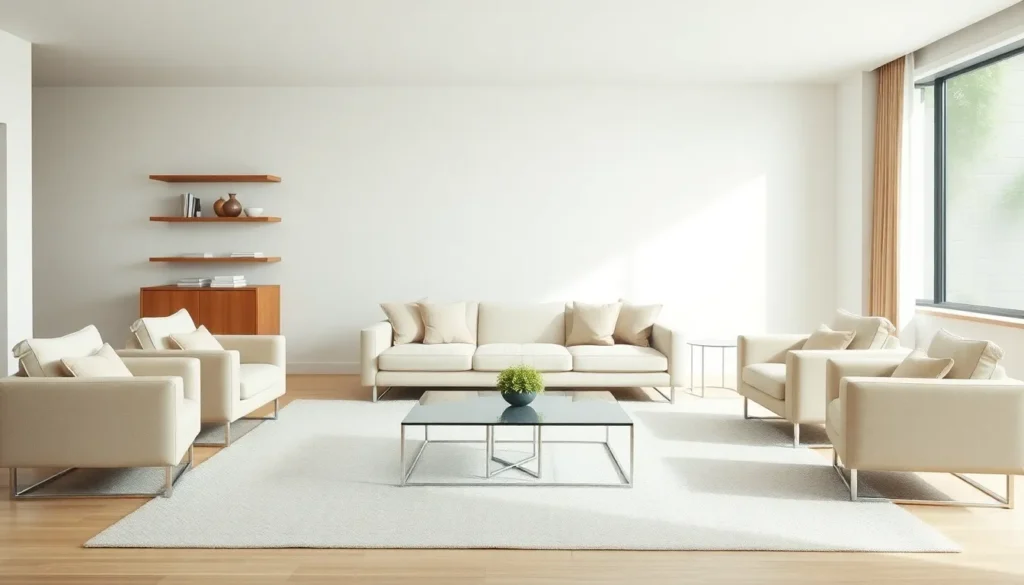Table of Contents
ToggleEver sat in a living room so cluttered it felt like you were trapped in a game of Tetris? It’s time to free those poor displaced couch cushions and embrace the beauty of minimalist living room furniture. Say goodbye to overwhelming chaos and hello to a space that breathes relaxation. Minimalism isn’t just a trend: it’s the art of simplifying your life and enhancing your living area.
Understanding Minimalism in Interior Design

Minimalism in interior design is about creating spaces that inspire serenity, functionality, and freedom from excess. This design philosophy emphasizes the idea that less is more, allowing individuals to distill their environment down to what truly matters.
When it comes to minimalist living rooms, the focus lies on simplicity, clean lines, neutral colors, and an overall uncluttered aesthetic. Think of the minimalist mantra as a gentle nudge towards intentional living. Furniture pieces should serve a purpose and contribute to the overall harmony of the space. By stripping away unnecessary decor and furniture, one can cultivate an environment that invites peace into daily life.
Benefits of Minimalist Living Room Furniture
The benefits of adopting minimalist living room furniture extend far beyond aesthetics. Here’s why you might want to consider making the switch:
- Clarity and Focus: A clean space leads to a clearer mind. By reducing visual clutter, individuals often find they can focus better on activities that bring joy.
- Easier Maintenance: Less furniture means less dusting, less vacuuming, and fewer surfaces to clean. Who wouldn’t want more time for Netflix binging?
- Enhanced Functionality: Minimalist furniture tends to be multifunctional. A sleek coffee table might also double as a storage unit, serving to maximize space without adding bulk.
- Timeless Style: Trends may come and go, but minimalist design often stands the test of time. Simple, elegant lines and forms create a look that remains sophisticated years down the road.
Key Pieces of Minimalist Living Room Furniture
Transitioning to a minimalist aesthetic often involves selecting a few key pieces of furniture that embody the spirit of simplicity. Here’s a curated list to get started:
Sofas
Your sofa is usually the centerpiece of the living room. Opt for a low-profile, sleek design devoid of excessive cushions and ornamentation. A neutral fabric in white, grey, or beige can adapt to any color scheme.
Coffee Tables
Choose a coffee table with clean lines, preferably made from materials like glass or light wood. This helps maintain an open and airy feel. Consider a table that offers storage to minimize surface clutter.
Shelving
Floating shelves can provide essential storage without overwhelming the walls. They maintain an open look while still offering space to display a few treasured items or books.
Accent Chairs
For seating, select accent chairs that reflect simplicity. An armless chair or a mid-century modern design often complements a minimalist space beautifully.
Choosing the Right Materials and Colors
Selecting the right materials and colors is essential in achieving a cohesive minimalist look. Here are a few tips:
- Materials: Natural materials like wood, metal, and glass work wonderfully. These can create a warm yet sophisticated ambiance. Consider matte finishes over glossy ones for a more subdued appeal.
- Colors: Stick to a neutral palette. Whites, greys, taupes, and soft earth tones provide a serene backdrop. A hint of color can be added through accessories or artwork, but the dominant shades should remain calm and soothing.
Tips for Arranging Minimalist Living Room Furniture
Arrangement is key in minimalist design. Here are some straightforward tips:
- Anchor the Space: Start by positioning the largest piece of furniture, typically the sofa, as the focal point. It should face any features like the TV or fireplace.
- Leave Space: Ensure there’s ample space between furniture pieces to foster flow. Avoid pushing everything against the walls: a little distance can create a more inviting atmosphere.
- Group Items Together: If you have multiple small items or furniture pieces, arrange them in groups. This allows for visual cohesion and makes managing clutter easier.
Maintaining a Clutter-Free Environment
Minimalism is not just about the initial setup: it’s also about maintaining that beautifully decluttered state. Here’s how:
- Routine Decluttering: Schedule regular decluttering sessions. Every month, evaluate what you need, and what can go. Remember, less is truly more.
- Store Smart: Use storage solutions that are both functional and aesthetic. Bins or baskets can hide items while still being on display.
- Mindful Purchases: Adopt a ‘one in, one out’ rule. For every new item brought in, consider letting go of another. This strategy helps prevent the accumulation of unwanted clutter.




